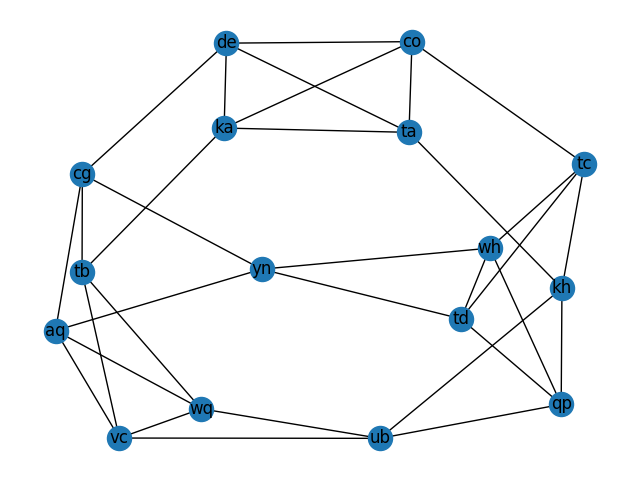
Advent of Code 2024 Day 23 – LAN Party
- 5 minsDay 23: LAN Party
Part 1
For today’s puzzle there’s a LAN party happening and we want to find someone that’s in the party. Our input is a list of every connection between two computers in the party. For example:
kh-tc
qp-kh
de-cg
ka-co
yn-aq
qp-ub
cg-tb
vc-aq
tb-ka
wh-tc
yn-cg
kh-ub
ta-co
de-co
tc-td
tb-wq
wh-td
ta-ka
td-qp
aq-cg
wq-ub
ub-vc
de-ta
wq-aq
wq-vc
wh-yn
ka-de
kh-ta
co-tc
wh-qp
tb-vc
td-yn
Each line represents a connection between two computers. For example, the first line kh-tc means that computer kh is connected to computer tc. Since the connections are bidirectional, the connection tc-kh would mean the same thing.
There are multiplayer games happening on the LAN party and we know the person we want to find is in a room. We need to find sets of 3 computers where every computer is connected to the other two to find these rooms. In this example, there are 12 such rooms:
aq,cg,yn
aq,vc,wq
co,de,ka
co,de,ta
co,ka,ta
de,ka,ta
kh,qp,ub
qp,td,wh
tb,vc,wq
tc,td,wh
td,wh,yn
ub,vc,wq
We know that the person we want to find has a computer name that starts with t, so we can filter out the rooms that don’t have a computer starting with t. In this case, we’re left with 7 rooms:
co,de,ta
co,ka,ta
de,ka,ta
qp,td,wh
tb,vc,wq
tc,td,wh
td,wh,yn
Our task is to find all the sets of 3 interconnected computers and then find out how many of these sets have a computer starting with t.
My Solution
This is actually a clique problem, which I first encountered when looking at NP-complete problems. I know how to solve this problem from my algorithms class, but I can also use well-known libraries that already have implementations for this problem. The library I’m going to use is networkx, which is a library for creating, manipulating, and studying complex networks.
I need to create a graph where each line in the input is an edge between two nodes. I can then use the library to find all the cliques of size 3 in the graph. Then I can sum up the number of cliques that have a node starting with t.
def main1():
G = nx.Graph()
with open("input.txt", "r", encoding="utf-8") as f:
for line in f:
u, v = line.strip().split("-")
G.add_edge(u, v)
triangles = []
for clique in nx.enumerate_all_cliques(G):
if len(clique) == 3:
triangles.append(clique)
if len(clique) > 3:
break
triangles_with_t = sum(
1 for triangle in triangles if any(node.startswith("t") for node in triangle)
)
# Print results
print(f"ANSWER1: {(triangles_with_t)}")
Explanation:
- I create a graph
Gusingnx.Graph(). - I read the input file and add each edge to the graph.
for clique in nx.enumerate_all_cliques(G):iterates over all the cliques in the graph.enumerate_all_cliquesis an iterator that yields all the cliques of size1tonin the graph. After finding all the cliques of size3, I break out of the loop, as I don’t need to find any more cliques.- I count the number of cliques that have a node starting with
tand print the result.
As always, I’ve only included the relevant parts of the code here, but to see my full solution, you can check out my Advent of Code GitHub repository.
Part 2
For part 2, we need to find the largest room in the LAN party. This would be the largest set of computers that are all interconnected. To get into the room, we need a password, which is the the name of every computer in the room, sorted alphabetically and concatenated together with commas in between. The largest room in the example is
ka-co
ta-co
de-co
ta-ka
de-ta
ka-de
with a size of 4, and the password for this room would be co,de,ka,ta.

Our task is to find the password for the largest room in the LAN party.
My Solution
I can use the same library and the same graph I created in part 1 to solve this. I just need to find the largest clique in the graph and then sort its nodes alphabetically.
def main2():
G = nx.Graph()
with open("input.txt", "r", encoding="utf-8") as f:
for line in f:
u, v = line.strip().split("-")
G.add_edge(u, v)
max_clique = max(nx.find_cliques(G), key=len)
max_clique = ",".join(sorted(max_clique))
print(f"ANSWER2: { max_clique }")
Again, I’ve only included the relevant parts of the code here, check out my repository for the full solution.
That’s it for day 23 of Advent of Code 2024! I hope you enjoyed reading my solution and let’s see how the rest of the month goes!
